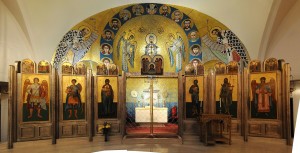
Recently I told the readers of my newsletter that I’m exploring writing of another kind: I’m “writing” an icon as taught in the Orthodox tradition.
I asked them to let me know if they would be interested in reading about the process.
- A number of people said “Yes.”
- Precisely the same number of people clicked “Unsubscribe.” (Oh well.)
- But still, nobody said “No.”
So, as we say at Presbytery meetings, “The ‘ayes’ have it.”
Especially because the “Yes” votes included both people whom I know well and whom I do not know personally at all, plus one who helped teach me iconography.
Plus, the “Yes” votes were enthusiastic. (I can’t tell how enthusiastically people were unsubscribing.)
The posts on iconography will be part of my Monday “inner life of the writer” series.
Telling you why is a good way to start the series.
Painting an icon is writing.
If you ever enter an Orthodox church one of the first things you will notice is the icons — paintings of Jesus and of Mary, of other Bible people and Bible stories, and of post-biblical saints.
- You will see them in the entry way.
- You will see a long row of them on the screen between the congregation and the altar table.
- You’ll see a couple on stands in front of that screen.
- You will see them, maybe many of them, on the walls.
- You’ll probably even see them on the ceiling.
You might be tempted to think that these are decorations. The Orthodox do refer to them that way at times. But really they are windows and, in a Protestant sense, pulpits.
As “windows” (a very traditional description) the faithful look not at icons but through them to the presence of God who is revealed in the people and scenes they portray.
As “pulpits” (my own word) the gospel is preached in them.
It is in this role as pulpits that icons use a language.
It is a very specific language, made up of
- line
- color
- and symbol.
And those who know the language quickly grasp the gospel message.
We Reformed Protestants don’t usually know that language. We emphasize only the spoken word. For us the gospel is proclaimed by the voice and received by the ear.
But in our culture we are increasingly aware that different people learn differently.
- Some do well with hearing a lecture.
- Some need to learn through activities for their bodies.
- And some learn better by seeing with their eyes.
Orthodox icons are, at the very least, a language for the visual learner to grasp and respond to the good news of Christ.
The very word “iconography” is as much about language as it is about painting. The “-graphy” at the end of the word means “writing.”
So iconography is just expanding my writing repertoire, kind of like I would if I were learning to write in French or Chinese.
Writing an icon is part of my inner life.
My first foray into iconography was a week-long workshop offered by the Prosopon School. My teachers were two master iconographers who immigrated from Russia years ago, Vladislav Andrejev (the founder of the school) and his son Dmitri.


(If you want to see some of their work, check out the school’s website above. If you’d like to own a wee bit of it and see it in detail, check out these awesome children’s books on two of the most popular Orthodox saints, illustrated by Vladislav in iconographic style.)
The teachers of the Prosopon School are steeped in the ancient traditional methods of iconography. More importantly to me, they are steeped in the spiritual teaching that lies behind the methods.
They emphasized from the beginning that artistic skill was not a prerequisite. That’s good: I like to draw but make no claims for my abilities.
In fact, fully half of our time together was spent listening to Vladislav lecture about the spiritual theology of Orthodoxy as embodied in iconography. Every element, every step, every technique, is rich with meaning and symbol.
And to write an icon according to the tradition, you need to know that theology and live into it as a spiritual practice.
Contemplating the symbolic meanings of the steps became a key aspect of the practice. It is all about prayer, and the journey toward restoration of the image of God in us.
I’m really happy to be exploring this kind of writing. I hope you’ll share the journey with me. And I hope you’ll share your thoughts along the way in the comments or by email.
(This post is the beginning of a series. Click here to go to the second one!)
————
This post contains affiliate links.

I’m sorry to hear that some people unsubscribed. I wonder if it was because of the icon question or if they were planning on leaving anyway?
Well, I’m excited about these posts. I’ll share them on my church’s FB page and maybe you’ll gain some subscribers!
Thanks Fr. Dustin.
There is no way to know exactly why people unsubscribe. Often I suspect that they signed up to get a free ebook and then forgot that this would be followed up with a weekly newsletter — so when an email arrives and they happen to notice it, they unsusbscribe. And some find they just have too much email in their boxes and want to winnow it a bit. In this case it was just kind of funny that the numbers matched exactly!
And thank so much for sharing the posts. It is one of the very best ways for readership to grow, and I take it as a great favor.